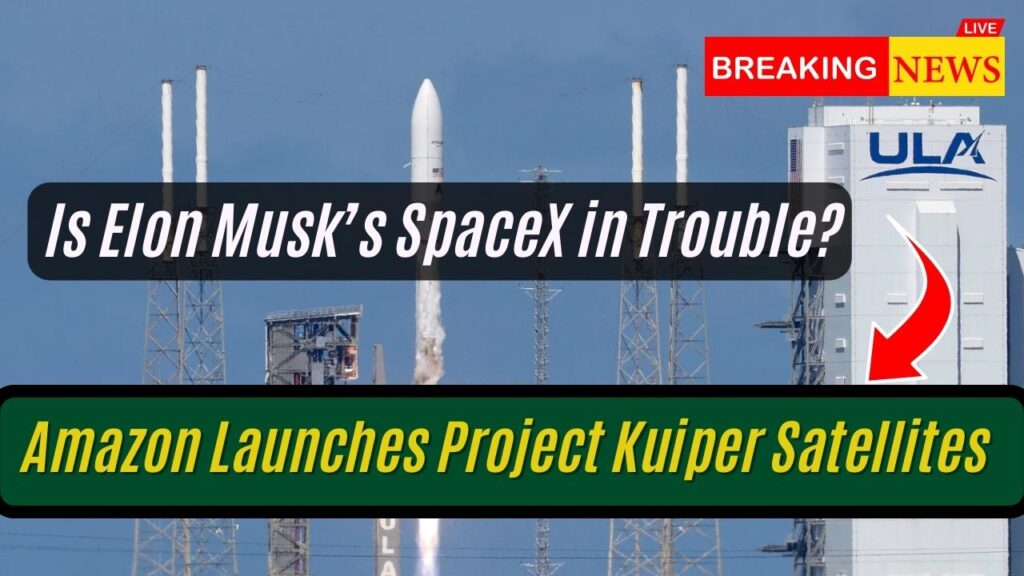Amazon Launches Project Kuiper Satellites – In a significant move to challenge SpaceX’s dominance in satellite internet services, Amazon has launched its first batch of Project Kuiper satellites. This development marks a pivotal moment in the race to provide global broadband connectivity from space.

Amazon Launches Project Kuiper Satellites
| Feature | Amazon Project Kuiper | SpaceX Starlink |
|---|---|---|
| First Operational Launch | April 28, 2025 | May 2019 |
| Satellites Deployed | 27 | Over 7,000 |
| Total Planned Satellites | 3,236 | Up to 42,000 |
| Current Subscribers | Service not yet launched | Over 4.5 million |
| FCC Deployment Deadline | 50% by July 2026 | N/A |
| Launch Partners | ULA, Blue Origin, Arianespace, SpaceX | In-house (SpaceX) |
| Customer Terminals | Under $400, speeds up to 400 Mbps | $599, speeds up to 1 Gbps |
| Official Website | Project Kuiper | Starlink |
Amazon’s launch of Project Kuiper satellites marks a significant step in expanding global internet connectivity. While SpaceX’s Starlink currently leads the market, Amazon’s strategic approach and resources position it as a strong competitor. The coming years will be crucial in determining how these developments shape the future of global broadband services. By entering the satellite broadband race with innovation, regulation compliance, and infrastructure investment, Amazon isn’t just trying to catch up—it’s laying the groundwork to lead.
Understanding Project Kuiper
Amazon’s Project Kuiper aims to deploy a constellation of 3,236 satellites in low Earth orbit (LEO) to provide high-speed, low-latency broadband internet globally. The project’s goal is to bridge the digital divide by offering internet access to underserved and remote areas worldwide. The recent launch of 27 satellites aboard a United Launch Alliance (ULA) Atlas V rocket from Cape Canaveral, Florida, signifies the commencement of Amazon’s full-scale deployment. This follows the successful launch of two prototype satellites in 2023.
The Competitive Landscape
SpaceX’s Starlink has been a frontrunner in the satellite internet sector, having launched over 7,000 satellites since 2019 and serving more than 4.5 million customers across 125 countries. Starlink’s extensive network provides high-speed internet, particularly benefiting regions with limited connectivity. Amazon’s entry into this market introduces significant competition. While Project Kuiper is still in its early stages, Amazon’s vast resources and strategic partnerships position it as a formidable contender.
Technical Specifications
Project Kuiper Satellites:
- Orbit Altitude: Approximately 630 km
- Inter-Satellite Links: Optical Inter-Satellite Links (OISL) for improved data transmission
- Customer Terminals: Compact design under $400, offering speeds up to 400 Mbps
- Power System: Solar arrays and battery backup for continuous operation
- Debris Mitigation: End-of-life deorbiting system to prevent space debris
Starlink Satellites:
- Orbit Altitude: Approximately 550 km
- Inter-Satellite Links: Laser links for enhanced connectivity
- Customer Terminals: Priced at $599, providing speeds up to 1 Gbps
- Power System: Advanced solar arrays with high energy conversion efficiency
- Debris Mitigation: Autonomous deorbit protocols
Regulatory Challenges
Amazon faces a critical deadline set by the U.S. Federal Communications Commission (FCC) to deploy at least 50% of its satellite constellation (1,618 satellites) by July 2026. Meeting this deadline is essential to maintain its license. Delays in manufacturing and launch schedules may necessitate Amazon to seek an extension from the FCC. In addition to U.S. regulations, Amazon must navigate international coordination with the International Telecommunication Union (ITU) and regional space authorities to ensure global spectrum use compliance and avoid frequency interference.
Strategic Partnerships
To expedite the deployment of its satellite network, Amazon has secured launch agreements with multiple partners, including ULA, Blue Origin, Arianespace, and even SpaceX. These collaborations aim to ensure timely launches and mitigate potential delays. Additionally, Amazon is developing ground infrastructure across multiple continents to support global connectivity and low-latency communications. The company is also investing in AI-driven network optimization to manage traffic routing, latency, and bandwidth distribution in real-time.
Market Implications
The satellite internet market is poised for significant growth, with increasing demand for reliable connectivity in remote areas. Amazon’s Project Kuiper, backed by substantial investment and strategic planning, is well-positioned to capture a share of this expanding market. However, SpaceX’s head start and established customer base present challenges for Amazon. Success will depend on Amazon’s ability to scale its operations efficiently and offer competitive services. Beyond broadband, the implications of Project Kuiper extend to industries such as agriculture, disaster relief, logistics, education, and telehealth, especially in regions where traditional infrastructure is lacking.
FAQs About Amazon Launches Project Kuiper Satellites
Q1: When will Amazon’s Project Kuiper be available to customers? Amazon plans to begin offering services later in 2025, following further satellite deployments and system testing.
Q2: How does Project Kuiper differ from Starlink? While both aim to provide global broadband via satellite constellations, differences lie in satellite design, customer terminal pricing, and strategic partnerships.
Q3: Will Project Kuiper be available worldwide? Yes, the goal is to offer global coverage, focusing on areas with limited or no internet access.
Q4: What are the potential benefits of Project Kuiper? Enhanced internet accessibility, economic development in remote regions, and improved emergency response communications.
Q5: How much investment has Amazon committed to Project Kuiper? Amazon has pledged over $10 billion toward building and deploying the Kuiper network.
Q6: Can Kuiper compete with Starlink’s established presence? While Starlink has an early lead, Amazon’s scale, logistics expertise, and technological ecosystem give it a competitive foundation. Time-to-market and service quality will be key differentiators.










